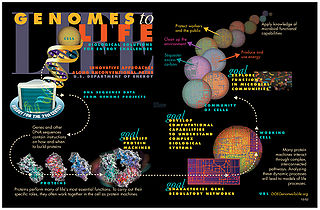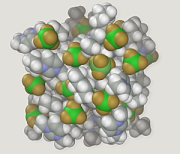Related Research Articles

Bioinformatics is an interdisciplinary field of science that develops methods and software tools for understanding biological data, especially when the data sets are large and complex. Bioinformatics uses biology, chemistry, physics, computer science, computer programming, information engineering, mathematics and statistics to analyze and interpret biological data. The subsequent process of analyzing and interpreting data is referred to as computational biology.

Computational biology refers to the use of data analysis, mathematical modeling and computational simulations to understand biological systems and relationships. An intersection of computer science, biology, and big data, the field also has foundations in applied mathematics, chemistry, and genetics. It differs from biological computing, a subfield of computer science and engineering which uses bioengineering to build computers.

Systems biology is the computational and mathematical analysis and modeling of complex biological systems. It is a biology-based interdisciplinary field of study that focuses on complex interactions within biological systems, using a holistic approach to biological research.
Mathematical and theoretical biology, or biomathematics, is a branch of biology which employs theoretical analysis, mathematical models and abstractions of living organisms to investigate the principles that govern the structure, development and behavior of the systems, as opposed to experimental biology which deals with the conduction of experiments to test scientific theories. The field is sometimes called mathematical biology or biomathematics to stress the mathematical side, or theoretical biology to stress the biological side. Theoretical biology focuses more on the development of theoretical principles for biology while mathematical biology focuses on the use of mathematical tools to study biological systems, even though the two terms are sometimes interchanged.

Molecular modelling encompasses all methods, theoretical and computational, used to model or mimic the behaviour of molecules. The methods are used in the fields of computational chemistry, drug design, computational biology and materials science to study molecular systems ranging from small chemical systems to large biological molecules and material assemblies. The simplest calculations can be performed by hand, but inevitably computers are required to perform molecular modelling of any reasonably sized system. The common feature of molecular modelling methods is the atomistic level description of the molecular systems. This may include treating atoms as the smallest individual unit, or explicitly modelling protons and neutrons with its quarks, anti-quarks and gluons and electrons with its photons.

In biology and other experimental sciences, an in silico experiment is one performed on a computer or via computer simulation software. The phrase is pseudo-Latin for 'in silicon', referring to silicon in computer chips. It was coined in 1987 as an allusion to the Latin phrases in vivo, in vitro, and in situ, which are commonly used in biology. The latter phrases refer, respectively, to experiments done in living organisms, outside living organisms, and where they are found in nature.
Modelling biological systems is a significant task of systems biology and mathematical biology. Computational systems biology aims to develop and use efficient algorithms, data structures, visualization and communication tools with the goal of computer modelling of biological systems. It involves the use of computer simulations of biological systems, including cellular subsystems, to both analyze and visualize the complex connections of these cellular processes.
The Virtual Physiological Human (VPH) is a European initiative that focuses on a methodological and technological framework that, once established, will enable collaborative investigation of the human body as a single complex system. The collective framework will make it possible to share resources and observations formed by institutions and organizations, creating disparate but integrated computer models of the mechanical, physical and biochemical functions of a living human body.
The physiome of an individual's or species' physiological state is the description of its functional behavior. The physiome describes the physiological dynamics of the normal intact organism and is built upon information and structure. The term comes from "physio-" (nature) and "-ome".

Galaxy is a scientific workflow, data integration, and data and analysis persistence and publishing platform that aims to make computational biology accessible to research scientists that do not have computer programming or systems administration experience. Although it was initially developed for genomics research, it is largely domain agnostic and is now used as a general bioinformatics workflow management system.
Igor I. Goryanin is a systems biologist, who holds a Henrik Kacser Chair in Computational Systems Biology at the University of Edinburgh. He also heads the Biological Systems Unit at the Okinawa Institute of Science and Technology, Japan.
The Living Human Project (LHP) is a project that begun in 2002 to develop a distributed repository of anatomo-functional data and simulation algorithms for the human musculoskeletal apparatus used to create the physiome of the human musculoskeletal system. In 2006 the BEL was merged with Biomed Town, an Internet community for those who have a professional interest in biomedical research.
Biology data visualization is a branch of bioinformatics concerned with the application of computer graphics, scientific visualization, and information visualization to different areas of the life sciences. This includes visualization of sequences, genomes, alignments, phylogenies, macromolecular structures, systems biology, microscopy, and magnetic resonance imaging data. Software tools used for visualizing biological data range from simple, standalone programs to complex, integrated systems.
Translational bioinformatics (TBI) is a field that emerged in the 2010s to study health informatics, focused on the convergence of molecular bioinformatics, biostatistics, statistical genetics and clinical informatics. Its focus is on applying informatics methodology to the increasing amount of biomedical and genomic data to formulate knowledge and medical tools, which can be utilized by scientists, clinicians, and patients. Furthermore, it involves applying biomedical research to improve human health through the use of computer-based information system. TBI employs data mining and analyzing biomedical informatics in order to generate clinical knowledge for application. Clinical knowledge includes finding similarities in patient populations, interpreting biological information to suggest therapy treatments and predict health outcomes.
Cardiophysics is an interdisciplinary science that stands at the junction of cardiology and medical physics, with researchers using the methods of, and theories from, physics to study cardiovascular system at different levels of its organisation, from the molecular scale to whole organisms. Being formed historically as part of systems biology, cardiophysics designed to reveal connections between the physical mechanisms, underlying the organization of the cardiovascular system, and biological features of its functioning.
In silico medicine is the application of in silico research to problems involving health and medicine. It is the direct use of computer simulation in the diagnosis, treatment, or prevention of a disease. More specifically, in silico medicine is characterized by modeling, simulation, and visualization of biological and medical processes in computers with the goal of simulating real biological processes in a virtual environment.
Multi-state modeling of biomolecules refers to a series of techniques used to represent and compute the behaviour of biological molecules or complexes that can adopt a large number of possible functional states.

Multiomics, multi-omics, integrative omics, "panomics" or "pan-omics" is a biological analysis approach in which the data sets are multiple "omes", such as the genome, proteome, transcriptome, epigenome, metabolome, and microbiome ; in other words, the use of multiple omics technologies to study life in a concerted way. By combining these "omes", scientists can analyze complex biological big data to find novel associations between biological entities, pinpoint relevant biomarkers and build elaborate markers of disease and physiology. In doing so, multiomics integrates diverse omics data to find a coherently matching geno-pheno-envirotype relationship or association. The OmicTools service lists more than 99 softwares related to multiomic data analysis, as well as more than 99 databases on the topic.
Cell-based models are mathematical models that represent biological cells as discrete entities. Within the field of computational biology they are often simply called agent-based models of which they are a specific application and they are used for simulating the biomechanics of multicellular structures such as tissues. to study the influence of these behaviors on how tissues are organised in time and space. Their main advantage is the easy integration of cell level processes such as cell division, intracellular processes and single-cell variability within a cell population.
References
- ↑ Bailey, J.E (1991). "Toward a science of metabolic engineering". Science. 252 (5013): 1668–1675. doi:10.1126/science.2047876. PMID 2047876.
- ↑ Kamath, Ravi S.; Fraser, Andrew G.; Dong, Yan; Poulin, Gino; Durbin, Richard; Gotta, Monica; Kanapin, Alexander (2003). "Systematic functional analysis of the Caenorhabditis elegans genome using RNAi". Nature. 421 (6920): 231–237. doi:10.1038/nature01278. hdl:10261/63159. PMID 12529635.
- 1 2 Varner, J. D. (2000). "Large-scale prediction of phenotype: Concept". Biotechnol. Bioeng. 69 (6): 664–678. doi:10.1002/1097-0290(20000920)69:6<664::AID-BIT11>3.0.CO;2-H.
- ↑ Sanford, Karl; Soucaille, Phillipe; Whited, Gregg; Chotani, Gopal (2002). "Genomics to fluxomics and physiomics — pathway engineering". Current Opinion in Microbiology. 5 (3): 318–322. doi:10.1016/S1369-5274(02)00318-1.
- ↑ Welch, G. Rickey (2009). "Physiology, physiomics, and biophysics: A matter of words". Progress in Biophysics and Molecular Biology. 100 (1–3): 4–17. doi: 10.1016/j.pbiomolbio.2009.08.001 . PMID 19699228.
- ↑ Kell, D.B.; Oliver, S.G. (2004). "Here is the evidence, now what is the hypothesis? The complementary roles of inductive and hypothesis-drive science in the post-genomic era". BioEssays. 26 (1): 99–105. doi:10.1002/bies.10385. PMID 14696046.
- ↑ Hunter, P.; Borg, T. (2003). "Integration from proteins to organs: the Physiome Project". Nature Reviews Molecular Cell Biology. 4 (3): 237–243. doi:10.1038/nrm1054. PMID 12612642.
- ↑ Bassingthwaighte, JB (2000). "Strategies for the Physiome Project". Annals of Biomedical Engineering. 28 (8): 1043–1058. doi:10.1114/1.1313771. PMC 3425440 . PMID 11144666.
- ↑ H. Perfahl, H.M. Byrne, T. Chen, V. Estrella, T. Alarcon, A. Lapin, R.A. Gatenby, R.J. Gillies, M.C. Lloyd, P.K. Maini, M. Reuss, M.R. Owen, 3D multiscale modelling of angiogenesis and vascular tumour growth, in, Micro and Nano Flow Systems Flow Systems for Bioanalysis, M.W. Collins and C.S. Konig (eds), Bioanalysis, 2,29-48(2013)https://people.maths.ox.ac.uk/maini/PKM%20publications/358.pdf
- ↑ A. Madzvamuse, R.D.K. Thomas, T. Sekimura, A.J. Wathen P.K. Maini, The moving grid finite element method applied to biological problems, In Morphogenesis and Pattern Formation in Biological Systems: Experiments and Models, Proceedings of Chubu 2002 Conference (T. Sekimura, S. Noji, N. Ueno and P.K. Maini, eds), Springer-Verlag Tokyo, 59-65 (2003) https://people.maths.ox.ac.uk/maini/PKM%20publications/158.pdf
- ↑ Gilmore, S.J.; Vaughan, Jr; Madzvamuse, A.; Maini, P.K. (2012). "A mechanochemical model of striae distensae" (PDF). Math. Biosci. 240 (2): 141–147. doi:10.1016/j.mbs.2012.06.007. PMID 22796062.
- ↑ White, S.M.; Burden, J.P.; Maini, P.K.; Hails, R.S. (2012). "Modelling the within-host growth of viral infections in insects" (PDF). J. Theor. Biol. 312: 34–43. doi:10.1016/j.jtbi.2012.07.022. PMID 22877574.